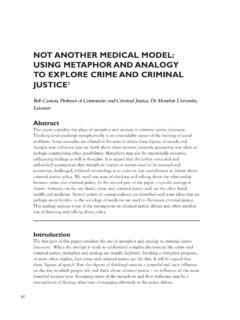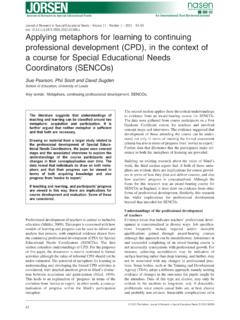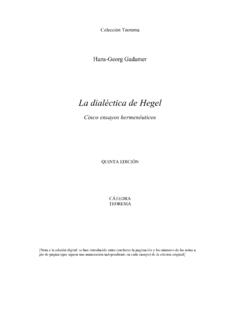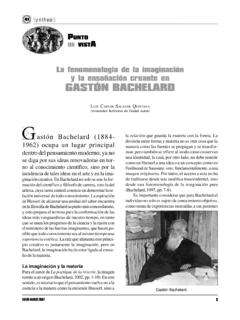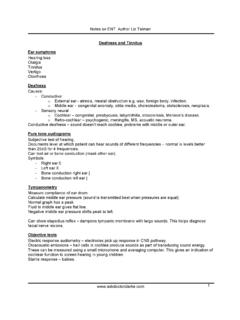Transcription of The Journeys of Life: Examining a Conceptual …
1 Metaphor and Symbol, 23: 148 173, 2008 Copyright Taylor & Francis Group, LLCISSN 1092-6488 print / 1532-7868 onlineDOI: Journeys of life : Examining aConceptual Metaphor with Semanticand Episodic Memory RecallAlbert N. Katz and Tamsen E. TaylorUniversity of Western OntarioIn four studies, we examine the life IS A JOURNEY Conceptual metaphorusing as data output from semantic and episodic memory. In the first three studiesoutput from semantic memory indicates that undergraduate samples, when primedto think in life in terms of a course followed until one s 70th year, provided aset of events output in a sequential order and when compared to a second sample,showed high agreement on the ages in which the events would occur. These datawere taken as supportive of a JOURNEY metaphor in which one progressedalong a life path. Study 2 indicated that the life events produced also arousedspecific subthemes, consistent with the notion of the arousal of lower-level life -JOURNEY metaphors ( , LOVE IS A JOURNEY ).
2 In a third study, weexperimentally constrained the order of report from semantic memory. These dataindicate that free output of events (as in Study 1) involves both a forward-temporaloutput, and clustering of life themes, but that forcing a forward-temporal orderis indicative of the arousal of the superordinate Conceptual metaphor but not thelower-level themes. Finally, in an episodic memory task one finds the reverse,namely arousal of the lower-level themes but not of the superordinate conceptualmetaphor. Taken together, these findings indicate conditions under which the LIFEIS A JOURNEY metaphor is facilitated, and when lower-level metaphors are mademore salient. In a more general way, the studies provide a new tool with which tostudy Conceptual it s inception with the publication ofMetaphors We Live By, (Lakoff andJohnson,1980) Conceptual metaphor theory has been influential in linguistics,Address correspondence to Albert N.
3 Katz, Department of Psychology, University of WesternOntario, London, Ontario, Canada N6A 5C2. E-mail: Conceptual METAPHOR149psychology, communication studies, and a host of other disciplines (for morerecent expositions see Kovecses, 2002; Lakoff, 1993). The fundamental tenetof the theory is that metaphor operates at the level of thinking, not languageper se. Metaphors link two Conceptual domains, the source domain (typicallyconsisting of literal and concrete entities and relationships) and the target domain (often a concept more abstract or less amenable to a simple description,such as LOVE or ANGER ). The target domain takes its structure andis understood in terms of the source domain, and thus how we conceptuallystructure, and talk about, the target domain parallels the structures and knowledgeheld about the better-delineated source domains are therefore believed to have relations between entities,attributes, and processes that mirror those found in the source domain.
4 At thelevel of language, one can thus find words and expressions (so-called metaphoricexpressions) about the target domain that refer directly or implicitly to thesource domain. Indeed the main source of evidence for the reality of conceptualmetaphors is based on patterns of word or expression use. Thus for instance,a proponent or Conceptual metaphor theory might notice in naturally occurringlanguage (or intuitively generate) the following metaphoric expressions (fromLakoff and Johnson, 1980, p. 28):Her ego is veryfragileHis mindsnappedHebrokeunder cross examinationI mgoing to piecesAnd from this infer a Conceptual metaphor, THE MIND IS A BRITTLEOBJECT. The identification of similarities between quite diverse metaphoric expressionand, indeed, the consideration of how we understand abstract concepts such as ANGER, DISEASE, and FREEDOM has made this theory very attractivein a wide range of disciplines.
5 Despite this popularity, evidence for the psycho-logical reality of Conceptual metaphors is largely based on examination ofpatterns of language use, largely has been uncritically accepted, and has not beensupported often when tested in ways other than through the intuitive linkingof patterns of language use (see for instance a critique by McGlone, 2007;methodological problems discussed in Semino, Heywood, and Short, 2004).In the studies reported here, examination of one metaphor identified byconceptual metaphor theorists ( life IS A JOURNEY ) will be examined to seeif evidence for it can be adduced from a database other than patterns of languageuse, namely, output from semantic and episodic AND TAYLORLIFE IS A JOURNEYC onsider the first lines of Dante Alighieri s literary masterpiece,The DivineComedy: Nel mezzo del cammin di nostra vita/mi ritrovai per una selvaoscura/ch la diritta via era smarrita[ Midway upon the journey of ourlife/I found myself within a forest dark/For the straightforward pathway hadbeen lost.]
6 ]. One can easily see here a mapping of two concepts, life and JOURNEY. According to Conceptual metaphor theory this mappingmotivates our understanding of life in terms of concrete knowledge about Journeys . Consider for instance some of the entailments that would follow from thismapping. Because Journeys define a path from a start to some end point, one candescribe life in path-appropriate terms such as: he stayed on the straight andnarrow, or my daughter seems always to be going around in circles, or hecame to a bad end, or, like Dante, find oneself at some midpoint place along thelong and winding path. Moreover, if one is on a path then one is also on somesurface and hence it is meaningful to make statements that relate to the type ofsurface of the path, such as my father just floated (or sailed) through life , or hetrudged along year by year, or, as in the Tom Cochrane song, life is a highway,I wanna ride it all night long.
7 And of course, like Journeys in general there canbe twists and turns in life such that one may find oneself at a crossroad, or ata roadblock, or lost, or in a safe place. In a journey one encounters placesthat one has passed or which one is trying to reach; in life the analogue would betransitional life episodes. Thus in lieu of stating I finally reached my goal thecity, one structures life s progress in similar language: I finally reached mygoal graduation. How would the study of memory be relevant to consideration of conceptualmetaphor? In the memory literature, a distinction is made between semantic and episodic memory. Semantic memory is comprised of knowledge of theworld represented in some permanent memory store. Such information includesknowledge such as Lassie is a dog or that the first letter of the word apple isan a or the stored belief that the world is flat.
8 This knowledge can be eitherdirectly represented in permanent memory or inferred from other informationstored in permanent memory. Conceptual metaphors thus would be parasitic onsemantic for instance asking people to describe life . We should haveavailable much knowledge about this topic in our memory: We can contrast itwith death or we can consider whether one can have a concept of artificiallife or what makes for a good life . In short, thinking of the concept of life does not necessarily evoke the JOURNEY metaphor, or may in fact evokeone or more of a lower-level aspect of the general metaphor, such as LOVE(or CAREER )IS A JOURNEY (Lakoff, 1993). Moreover, cognitive linguistsEXAMINING Conceptual METAPHOR151have argued for other appropriate metaphors for life , such as life ISA CONTAINER ( He had a full life ; I feel so empty )or life IS ABUILDING ( doors kept opening for me she seems always on an elevator,you never know if she is going to be up or down )or life IS A GAME ( you have to deal with what you are dealt, you got to know when to hold em, know when to fold em ).
9 We argue here that the life IS A JOURNEY metaphor would be evoked when people are primed to think of thecourseoflife tied to a time dimension; other source domains could be activated by otherprimes. When primed by thinking of the course life takes across time, one wouldexpect that entailments from Journeys should structure what informationis elicited from semantic memory and how it is the studies reported here we will examine whether output from semanticmemory provides evidence for the JOURNEY metaphor, and the conditionsthat might favor the arousal of this metaphor. The first three studies reportedhere examine the semantic memorial information held about the course of Study 1, stored knowledge about the events that occur over course of theaverage person s life will be identified for a large group of undergraduate studentsand expectations drawn from the JOURNEY metaphor examined (Study 1).
10 The life events identified in that study then will be subjected to hierarchicalclustering techniques to see whether we can find evidence that life events outputfrom semantic memory is structured along a single path or, as suggested byconsideration of higher- and lower-level metaphors (see Lakoff, 1993), in a morevaried or multidimensional fashion (Study 2). To anticipate the findings slightly,a set of specific subgroupings were identified. In Study 3 we will experimentallyconstrain the manner in which life events are output from semantic memory toidentify conditions that encourage use of a unidimensional (path) JOURNEY and conditions that encourage the use of the second form of memory is episodic memory: memory for specific eventsthat are tied to when, where, and how those events were encountered. Typically,this has been studied through memory for presented events, in which the eventinvolves experimentally controlled materials, such as a list of words or a film.
